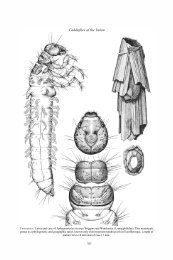(Ephemeroptera) of the Yukon - Department of Biological Sciences
(Ephemeroptera) of the Yukon - Department of Biological Sciences
(Ephemeroptera) of the Yukon - Department of Biological Sciences
Create successful ePaper yourself
Turn your PDF publications into a flip-book with our unique Google optimized e-Paper software.
162 P.P. Harper and F. Harper<br />
due no doubt to its direct links to more sou<strong>the</strong>rly drainages and its more clement meteorological<br />
conditions; indeed, Harper and Harper (1981) already observed <strong>the</strong> large number <strong>of</strong><br />
typically eastern Nearctic species whose distribution extends in a northwestern direction into<br />
<strong>the</strong> Mackenzie drainage; <strong>the</strong>se species probably migrated westwards through <strong>the</strong> “West<br />
Agassiz” route when <strong>the</strong> Mackenzie River system drained to <strong>the</strong> sou<strong>the</strong>ast into Lake Agassiz<br />
(Flannagan and Flannagan 1984). As well, Allen’s (1990) distribution patterns show many<br />
species extending from <strong>the</strong> western United States along <strong>the</strong> Cordillera into <strong>the</strong> Mackenzie<br />
drainage, for instance his “northwestern” (71 species), “Rocky Mountain” (11 species), and<br />
“northwest and Rocky Mountain” (8 species) patterns. This richness in species appears to<br />
decrease rapidly westwards, and only 15 taxa are reported from <strong>the</strong> Porcupine drainage,<br />
flowing west into <strong>the</strong> <strong>Yukon</strong> River (Wiens et al. 1975; Cobb and Flannagan 1980).<br />
The <strong>Yukon</strong> mayfly fauna as currently known contains 4 zoogeographical elements:<br />
1. The widespread Cordilleran species, which form <strong>the</strong> majority <strong>of</strong> <strong>the</strong> fauna, have<br />
geographical distributions which run along <strong>the</strong> western mountain ranges and extend northward<br />
into Alaska (“widespread western” in Allen’s (1990) classification); such are Acentrella<br />
insignificans (2), Callibaetis ferrugineus hageni (6), Caenis youngi (9), Drunella spp.<br />
(10 –12), Cinygmula spp. (14 –16), Epeorus longimanus (18), Rhithrogena futilis (20),<br />
Siphlonurus occidentalis (27), and S. phyllis (28).<br />
2. A small number <strong>of</strong> Holarctic species, most <strong>of</strong> <strong>the</strong>m restricted in North America to <strong>the</strong><br />
nor<strong>the</strong>rnmost part <strong>of</strong> <strong>the</strong> continent where <strong>the</strong>y extend from west to east: <strong>the</strong>se are Baetis<br />
bicaudatus (3), B. bundyae (4), Ephemerella mucronata (13), Metretopus borealis (24), and<br />
Siphlonurus alternatus (26). They do not fall readily into any <strong>of</strong> Allen’s (1990) patterns,<br />
though B. bundyae (as B. macani) was included in his “Nearctic pattern”. They correspond<br />
to Flannagan and Flannagan’s (1984) “north transcontinental” fauna. Ephemerella mucronata<br />
does not appear to extend east <strong>of</strong> <strong>the</strong> Mackenzie Valley, and is <strong>the</strong> only element <strong>of</strong> <strong>the</strong><br />
fauna to have a Beringian distribution in North America.<br />
3. A few species <strong>of</strong> transcontinental distribution which reach <strong>the</strong>ir nor<strong>the</strong>rnmost<br />
extension in <strong>the</strong> <strong>Yukon</strong> and/or Alaska (“pancontinental pattern” <strong>of</strong> Allen (1990) and “south<br />
transcontinental” <strong>of</strong> Flannagan and Flannagan (1984)): Baetis tricaudatus (5), Procloeon<br />
ingens (7), Leptophlebia nebulosa (22) and Paraleptophlebia debilis (23).<br />
4. The westernmost extension <strong>of</strong> a nor<strong>the</strong>astern Nearctic fauna, typically distributed<br />
over eastern Canada and <strong>the</strong> nor<strong>the</strong>astern United States, generally over <strong>the</strong> eastern glaciated<br />
areas (“nor<strong>the</strong>ast” pattern <strong>of</strong> Allen (1990)); <strong>the</strong> only species included are Heptagenia pulla<br />
(19) and Siphloplecton prob. interlineatum (25).<br />
There is no endemic element; <strong>the</strong> status <strong>of</strong> Siphlonurus sp. (cf. autumnalis) (29) needs<br />
to be clarified before anything more can be said about it. We have found no evidence <strong>of</strong><br />
unexpected species with widely disjunct distributions, as did McCafferty (1985) in Alaska<br />
(e.g. Ephemerella lacustris and Cinygmula subaequalis). The fact that parts <strong>of</strong> <strong>the</strong> <strong>Yukon</strong><br />
and <strong>of</strong> Alaska have remained unglaciated during <strong>the</strong> last glaciations is used by McCafferty<br />
to explain <strong>the</strong> existence <strong>of</strong> <strong>the</strong>se disjunct elements. Such species are <strong>of</strong> great potential<br />
zoogeographical interest, but more information is needed on <strong>the</strong>ir identity and distribution<br />
before <strong>the</strong> significance <strong>of</strong> <strong>the</strong>ir presence can be assessed.<br />
The relatively larger contribution <strong>of</strong> western elements as compared to eastern indicates<br />
that <strong>the</strong> <strong>Yukon</strong> is clearly within <strong>the</strong> western zoogeographical province. The eastern influence,<br />
dominant in <strong>the</strong> Prairies (Lehmkuhl 1980) and still prevalent in <strong>the</strong> Mackenzie Valley<br />
(Harper and Harper 1981), is considerably weakened. The mountain ranges <strong>of</strong> <strong>the</strong> eastern<br />
<strong>Yukon</strong> and <strong>the</strong> increasingly harsh wea<strong>the</strong>r conditions are thus effective barriers to colonization<br />
by species <strong>of</strong> eastern and sou<strong>the</strong>astern origin.
















